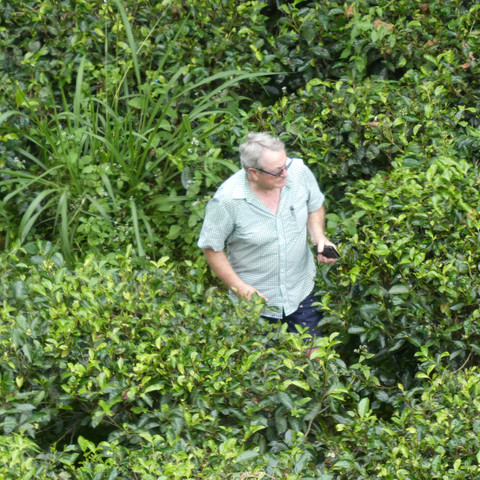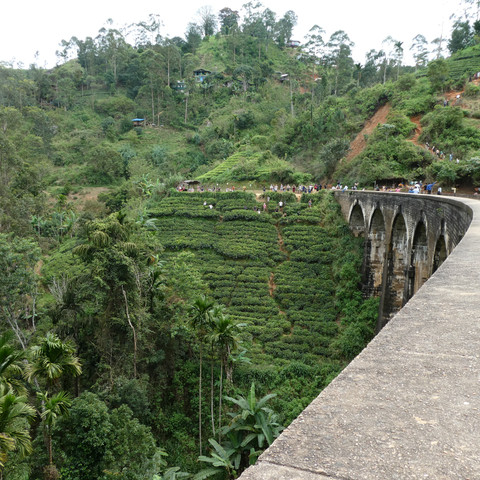Day eleven: Explore Sri Lankan wildlife at Yala National Park
- Janette Frawley

- Jan 23, 2020
- 9 min read
In the morning you’ll depart from Ella to visit Yala National Park. It is the largest and most visited national park in Sri Lanka. Thanks to a river running through it, Yala National Park is divided into two sections. Because the river makes crossing to the other side difficult, Yala is really treated as two separate parks. But that doesn’t change the fantastic offerings! From elephant and leopard spotting, jeep safaris, and many historical and religious ruins to explore. This place is blessed with natural resources, so there are many things that will keep you busy.

2/1/2020
The clouds outside our ‘eagle’s nest’ are scattered with splodges of orange colour as the sun makes its way up from the horizon. I watch as the brief sunrise sends its rays out to herald a new day. As I open the door to the balcony, I hear the chants from a nearby Buddhist temple; deep, resonating sounds of the devout. Calming, yet musical and pleasing to the ear.

We had arrived late yesterday afternoon after being on the train for almost four hours, so it had been impossible to visit the attractions for which Ella is famous; the Nine-Arch Bridge and Ravana waterfall. At breakfast, we discuss our day’s activities with the driver. Since we had seen elephants in their natural habitat in the Minneriya/Kaudulla National Park, we don’t need to do another safari. The driver mentions leopards, but since he cannot guarantee that we will see them, we opt to visit the attractions here in Ella before taking the two-hour drive to Yala.
Keeping in mind the last two night’s accommodation trickery and attempted trickery, we ask the driver to contact tonight’s hotel, The Grand Yala, to ensure that we have secured one of the two superior rooms in the hotel as per the itinerary, as we will not arrive in Yala until late afternoon. Ella is a beautiful town, and it would have been nice to be able to stay two nights in our rooftop room. I’m sorry we didn’t spend more time going through the itinerary when we realised this wasn’t a group tour. The special grassroots-type experiences I had requested and hoped for haven't materialised and our brief forays into the local towns have not been as productive as we expected. Of course, the language difficulties between our driver and us haven't helped the situation.
We drive along another pot-holed road. The recent heavy rains have played havoc with not only the roads, but the steep mountainsides; landslides and rockfalls must be cleared before roads can be mended. Out on a remote road, some fifteen minutes from Ella, a group of stalls and tuk-tuks are gathered. We are led to one of the drivers and told it will cost 3,000 rupees (about $24) for the tuk-tuk to take us one kilometre down the road. We would have to walk the remaining 800 metres down to the Nine-Arch Bridge. Last night, it had cost 300 rupees ($2.40) for a tuk-tuk to collect us from our hotel and drive down the mountain to a restaurant, a distance of two kilometres. Since the tuk-tuk driver wouldn’t budge on price, we decide to walk the 1.8 kilometres. One tends to have 20/20 vision when recounting an experience in hindsight, but despite our experience, which I will outline in detail, there are other alternatives to reach the Nine-Arch Bridge, none of which had been conveyed to us.
We set off and shortly after, see a fork in the road. The sign points to the upper road, although Tom is convinced that we should be walking on the lower one. I should have taken his advice, but eventually he relents and we climb up the hill, following the track around, until we come to a dead end. There is a house at the end of the road. A lady comes out of it and asks whether we are here to see the Nine-Arch Bridge. Nodding in the affirmative, she turns and beckons us to follow, mentioning a ‘shortcut’ in passing. Through another backyard, over a dead tree trunk, along a barely discernible goat track, she points down – way down – to our destination. In fact, we are basically standing right above the bridge we have come to visit. She then points us to a set of steps crudely cut into the red, sticky clay.
‘Follow’, she says before leaving us to return to her home and family. I think she finds another lost group in her back yard because within a short time, a British couple come up from the rear. I’m very slow and I need to ensure that my feet are firmly planted on the ground before making a move. Tom is more the ‘mountain-goat’ type; able to walk steadily up and down these uneven tracks without barely raising his heart rate. The descent, for me, is like climbing down Mt Everest. It is steep, slippery and, in some parts, foot-twistingly dangerous. On the cliff side, there is little vegetation left to grab onto, and what little there is, has already been half-pulled out by trekkers before me, so it’s not that reliably anchored. On the left side, some bright spark has installed three strands of barbed wire. Grabbing the collar of Tom’s shirt, step by gruelling step, we make the slow descent, finally reaching flat ground and the railway line on which we had travelled yesterday. I must have looked as if I was about to have a heart attack when I reach flat ground as a man hurries up to me, his water bottle open and offers me a drink.
‘It’s OK,’ I rasp as I see Tom scampering ahead.
Checking my watch, I decide we have plenty of time to explore and probably leave before the next train crosses the bridge at 11:40am. From the flat natural terrace, I ask Tom to step into the tea plantation below us so I can take a photo of him with the bridge behind. In the time that it takes me to extract the camera and turn it on, he has disappeared. Not where I think he should be! Nowhere to be seen! Then I see a green-coloured shirt way down at the base of the bridge, partially hidden by tea bushes.
My face is still the colour of a beetroot, although my breathing has returned to normal. Momentarily, the thought of leaving this place terrifies me because climbing up those steps might be a little challenging. No. A big bit challenging! I’ll think about that later. I realise how unfit I really am.
The Nine-Arch Bridge is a viaduct bridge, and is one of the best examples of Colonial-era construction in Sri Lanka. The construction of the bridge is attributed to local Ceylonese builder, P.K. Appuhami, in consultation with British engineers. Located between the Demodara and Ella stations, the bridge’s allocation of steel may have been reassigned to Britain’s war-related projects at the battlefront during the Great War. The work came to a standstill until locals pulled together to build it with stone and concrete, proving that steel was not really required. It was completed in 1921.
After a refreshing drink of coconut water, we notice a few policemen wandering around. I check my watch again and with about an hour to go before the train is scheduled to cross the bridge, we decide to walk along the lines and through the tunnel on the other side. I can appreciate the marvellous feat of engineering and construction of the Nine-Arch Bridge. It would have been a valuable link between the towns in this hilly part of Sri Lanka. Britain’s legacy to Sri Lanka and to a greater extent, India and Africa, is the railway system it built and that is used to this day.
As much as I would love to be here when the train rumbles through, passengers standing or sitting at the open doors to wave at the visitors here, it is time to leave. Beside the tunnel, there are the usual gaggle of tuk-tuks, and for a reasonably small fee of 1,000 rupees ($8.00), we are able to ride back to Ella town. We’ll contact the driver when we are ready to be collected from Ella, as we have no desire to ask the tuk-tuk driver to take us back to our starting point. Over washed out roads, rough patches, unmade clay, and partially sealed tracks, it takes us almost thirty minutes inside the bone-shaking little vehicle. The tuk-tuks are incredibly versatile in this country, where infrastructure is not in good repair. Without these little vehicles, it would be next to impossible to see as much of the country as we have.

Grabbing the opportunity, we stop in a coffee shop to savour the flavour of local Sri Lankan-grown coffee. We find that neither our local phone or our Australian one can connect with our driver, but when I see one of the other drivers from our hotel walking across the road, Tom runs after him to ask him to call our driver on our behalf. Within seconds, our driver appears, which makes me wonder whether he had been actually waiting for us at the drop-off point. Perhaps he’d been cruising around town looking for us. He obviously doesn't trust us!
We reluctantly leave Ella through the mountainous main road. Ahead, we see the remnants of a landslide, where boulders had flung themselves down the mountain, blocking the road on October 25 last year. More recently, and since we arrived in Sri Lanka, further rain has threatened the roads. At different times, huge boulders have dislodged from the steep sides, and in one case, a café has been built on top of a huge boulder wedged on the side of the mountain. I’m not sure that I would feel too safe in this place, unless it has been cantilevered from the top of the mountain to look as if the rock is holding it up.
The Ravana waterfall, six kilometres from Ella, is twenty-five metres in height, and cascades from an oval-shaped rocky outcrop way up near the top of the mountain. It is also the widest of all waterfalls in Sri Lanka. The recent rain means that the water is spilling over at a fast rate, and as we walk down to a viewing platform, we appreciate why this is one of Sri Lanka’s most popular attractions. Although we didn’t get up close and personal to explore the base of the waterfall, there is a cave there, in which archaeologists have uncovered evidence that humans lived here some 25,000 years ago.
A man, resplendent in an orange sarong, which thankfully must be firmly tied, stands in front of a pipe, through which a torrent of water gushes. He doesn’t move. I think he is paid to stand there. The beautiful, water-filled rocky sides of the cliffs provide nourishment for the hundreds of ferns, which live in the cracks and crevasses. As we wait our turn to stand at the prime viewing spot for photographs, we gaze in awe at the wonderful way in which the water has found an outlet to cascade down the mountain. Many stalls selling cheap junk and fruit gather on this bend in the road, plying their trades and making a nice income from the hundreds of tourists that arrive here each day.
It’s time to say goodbye to Ella and start the journey to Yala. Our journey is almost uneventful. It is the first day of school after a month’s holiday over Christmas and New Year. We drive through one town in time to see children, wearing spotless white uniforms, leaving school for the day. I do wonder how the uniforms are kept so clean.
Suddenly, somewhere out in the country the car stops in the middle of the road. The driver jumps out. I jump out as well, camera in hand, as I watch him turn two turtles over onto their legs and move them off the road with his foot. Once safe in the grass, they start to slowly move away. From my seat in the back of the car, I didn’t realise that both turtles, for whatever reason, were on their backs in the middle of the road. It’s just as well our driver saw them before he hit them with the car. It’s not often one would find turtles wandering on a road.
Our otherwise almost perfect day turns a little sour when our driver, on arrival at the hotel tells us that the room that we had requested was not available. Again, we have been messed around, and yet again, have ended up with less than what we had paid for and what was advertised. When we earlier asked whether he had called the hotel, we didn’t follow up and ask him to elaborate on the conversation. It appears that each day there is a different issue with our accommodation.
We take a walk and wander through the village streets before the veil of darkness begins to descend and the mosquitoes sharpen their stings. We recognise a couple that we had seen at the hotel in Ella. Malaysian Australians, they too, are touring Sri Lanka with the same company in the back of a car as inadequate as ours. We decide to have our included dinner with them and share many personal travel experiences with them.
Tonight, Tom can find only one television station with a signal. It is a children’s channel, and it is in English. We learn a new song. Sung to the tune of Bingo, it is called Oscar and it’s about a cat.
'There was a farmer, had a cat,
And OSCAR was its name-o
O-S-CAR, O-S-CAR, O-S-CAR and Oscar was it's name-o'
I wonder what tomorrow will bring. Hopefully more than one television station…
TOUR: Across the Best Sites of Sri Lanka - Capital Lanka Tours
ACCOMMODATION: The Grand Yala Hotel, Tissamaharama, Sri Lanka Ask for one of the two upstairs rooms.























Comments